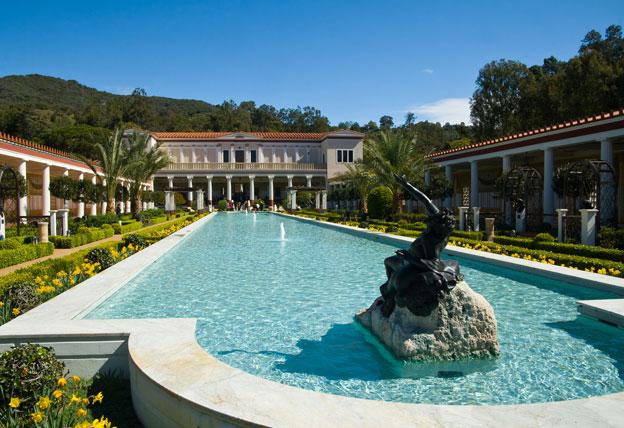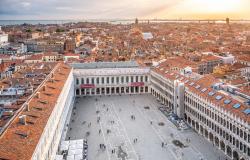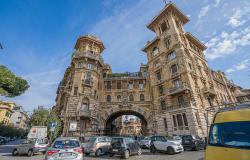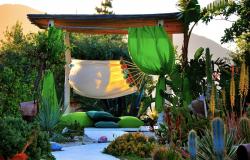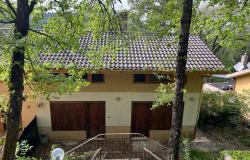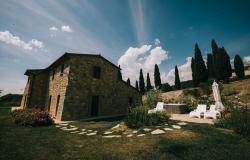“A setting that brings the spirit of ancient Rome civilization to life.”
The setting is the Getty Villa, a faithful reproduction of what a Roman villa of 2,000 years ago would look like. What perhaps is unexpected is its location: Malibu, California.
For anyone who’s sneering at the idea of a Roman villa along the Pacific coast of California, in an area normally associated with celebrities and their villas, I can assure you this isn’t anything like the Bellagio and Venetian resorts of Las Vegas, or a "Disneyland version" of ancient Roman housing.
I visited the Getty Villa last March. I was myself a bit skeptical, however, I was quite impressed with what was achieved.

The Inner Peristyle (Photo: Julius Shulman and Juergen Nogai © 2006 J. Paul Getty Trust)
The design of the villa is conceived to make visitors feel as if they were entering an archeological dig, similar to what they would find in Herculaneum, the wealthy Roman town destroyed, alongside Pompeii, by the eruption of Mount Vesuvius in 79 AD.
Why Herculaneum?
Because the Getty Villa is modeled after the Villa dei Papiri (Villa of the Papyri), a large country house from the 1st century BC located in Herculaneum. It is believed the villa belonged to Julius Caesar’s father-in-law, Lucius Calpurnius Piso, a powerful consul and rich land owner.
J. Paul Getty, the oil tycoon and art lover wanted to provide a context for his large collection of precious Roman, Greek and Etruscan artifacts. He was so fascinated by the Villa dei Papiri and its history that he decided to build a replica to house his expanding art collection and share it with the public. Because most of the original Villa dei Papiri remains buried under layers of volcanic ash, the architects of the Getty Villa based the floor plan on a precise map drawn by the engineers who had worked on the original excavation and gathered architectural details from other Roman homes of Pompeii, Herculaneum and Stabiae.
Ironically, Getty never saw the villa. He died in England, where he had moved, without ever seeing the completed site, which opened in 1974.

The Outer Peristyle
Roman villas were meant to impress. And impressed I was as a guide showed me around during a very informative Architectural Tour.
Moving from the Atrium, the main public room in a Roman house, where business was conducted, to the Inner Peristyle, where the family quarters were located, I was surrounded by bronze statues, busts, Corinthian columns and lavish fountains. The numerous statues and busts displayed throughout the villa are faithful reproductions of the originals, which are kept at the Naples National Archaeological Museum. Every detail contributes to make you feel as if you were in the ancient world of the Romans. By the way, did I mention that even the road that leads to the parking lot simulates a Roman road, paved with large, irregular stones?
I proceeded to the most outstanding area of the villa, the Outer Peristyle. This was the most private part of an ancient Roman home: if you were not an invited guest, you would never see this side of the house. This area was used for exercising: swimming in the large pool, walking in the garden, and for entertaining, when lavish pool parties were organized. But it could also offer a peaceful place for conversation and contemplation. Roman villas were in fact based on Epicurean philosophy, which favored peace and tranquility over power and money, the guide explained.
Just like in a Roman villa, the gardens at the Getty Villa feature an incredible array of plants and herbs, all from Mediterranean species that could be found at the time of the Romans. Herbs were very important: they were used in cosmetics, cooking and medicine, as tribute to gods and, not to be underestimated, to cover bad odors. Plants to be found at the Getty Villa include rosemary, caper, olive trees, mint, oregano, fig, lavender and many more.

The East Garden with replica of fountain from the House of the Large Fountain at Pompeii (Photo: Ellen Rosenbery
© 2005 J. Paul Getty Trust)
The J. Paul Getty Museum on the second floor houses the impressive collection of more than 1,200 works of art arranged thematically, as well as approximately 44,000 Greek, Roman and Etruscan antiquities. Together, they represent 7,000 years of ancient art, spanning a period that goes from the end of the Stone Age to the fall of the Roman Empire.
I realized the half day I had set apart was not enough. And even if this is not a real Roman villa, I really appreciated the care with which history has been recreated and precious artifacts are being preserved, as I am from a country -Italy- that too often neglects its immense artistic and historic heritage.
I made a plan to return, to immerse myself again in this ancient world, with views of the Pacific Ocean.
*The Getty Villa is typically described as being in Malibu, even by the museum itself. It is actually in the community of Pacific Palisades, which is part of the city of Los Angeles. Technically, Malibu begins one mile west.
To learn more about the Getty Villa and how to plan a visit, check the website.
